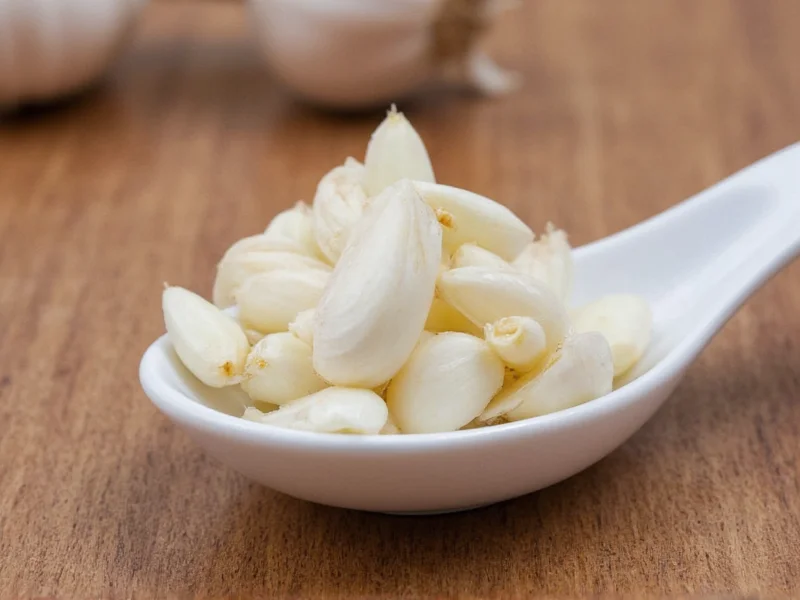Converting garlic cloves to teaspoons is essential for precise cooking and baking. Many recipes specify measurements in teaspoons while others call for specific numbers of cloves, creating confusion in the kitchen. Understanding this conversion ensures your dishes achieve the perfect garlic flavor without overpowering other ingredients.
Understanding Garlic Measurements
Garlic measurements aren't standardized because cloves vary significantly in size. A single head of garlic typically contains 10-12 cloves, but their individual dimensions differ based on garlic variety and growing conditions. This natural variation explains why precise conversion matters for consistent cooking results.
Garlic Clove to Teaspoon Conversion Chart
| Garlic Size | Chopped Garlic | Minced Garlic | Garlic Paste |
|---|---|---|---|
| Small Clove (0.5" diameter) | 3/4 teaspoon | 1/4 teaspoon | 1/8 teaspoon |
| Medium Clove (0.75" diameter) | 1 teaspoon | 1/2 teaspoon | 1/4 teaspoon |
| Large Clove (1" diameter) | 1 1/2 teaspoons | 3/4 teaspoon | 1/2 teaspoon |
| Jumbo Clove (1.25" diameter) | 2 teaspoons | 1 teaspoon | 3/4 teaspoon |
Factors Affecting Garlic Measurement Accuracy
Several variables influence how much volume a garlic clove produces when prepared:
Preparation Method
The way you prepare garlic dramatically changes its volume. Chopping creates larger pieces with more air space between them, yielding more volume than finely minced garlic. Garlic paste, made by crushing cloves with salt, produces the most concentrated measurement.
Clove Size Variability
Garlic size depends on multiple factors including variety (softneck vs hardneck), growing conditions, and storage time. Older garlic tends to shrink as it dries out, while freshly harvested garlic contains more moisture and yields slightly more volume.
Measurement Technique
How you fill your teaspoon affects accuracy. For chopped garlic, lightly spooning the pieces into the measure without packing yields the standard conversion. Packing the garlic down can double the actual amount, potentially overwhelming your dish with garlic flavor.
Practical Kitchen Applications
When following recipes that specify "garlic cloves" but you only have pre-minced garlic, or vice versa, these practical applications help maintain recipe integrity:
- Recipe Scaling: When doubling a recipe that calls for 3 cloves of garlic, use 1 1/2 teaspoons of minced garlic instead of guessing
- Flavor Control: Start with 3/4 of the recommended amount, then adjust to taste after cooking begins
- Time-Saving Prep: Mince multiple cloves at once and store extras in olive oil for up to 5 days
- Substitution Guide: When fresh garlic isn't available, use 1/8 teaspoon garlic powder per medium clove
Common Measurement Mistakes to Avoid
Many home cooks make these critical errors when converting garlic cloves to teaspoons:
- Ignoring preparation method - using chopped measurements for minced garlic applications
- Overpacking the spoon - pressing garlic down instead of lightly filling
- Not accounting for size variation - treating all cloves as identical
- Using dried measurements for fresh - garlic powder requires completely different ratios
Garlic Substitution Guidelines
When fresh garlic isn't available, these substitutions maintain flavor balance:
- 1 medium fresh garlic clove = 1/8 teaspoon garlic powder
- 1 medium fresh garlic clove = 1/2 teaspoon garlic juice
- 1 medium fresh garlic clove = 1/4 teaspoon garlic salt (reduce additional salt by 1/4 teaspoon)
- 1 medium fresh garlic clove = 1/2 teaspoon garlic paste
Remember that dried garlic products have more concentrated flavor than fresh. When substituting, start with less than you think you need, then adjust to taste after cooking has begun. The conversion from fresh garlic to dried isn't linear due to moisture content differences.
Professional Chef Tips for Garlic Measurement
Experienced chefs use these techniques for perfect garlic measurements every time:
- Standardize your prep - chop or mince all garlic using the same technique for consistency
- Measure after preparation - never estimate volume before chopping
- Consider cooking time - longer cooking periods mellow garlic flavor, allowing for slightly higher measurements
- Use a kitchen scale - for absolute precision, weigh minced garlic (1 teaspoon = approximately 2 grams)
Understanding the relationship between garlic cloves and teaspoon measurements transforms your cooking precision. This knowledge prevents the common pitfalls of either under-seasoning dishes or overwhelming them with excessive garlic flavor. Whether you're following a family recipe that specifies "3 cloves" or a professional cookbook that uses teaspoon measurements, accurate conversion ensures culinary success every time.
How many teaspoons is 2 cloves of garlic?
Two medium garlic cloves equal approximately 1 teaspoon of minced garlic or 2 teaspoons of chopped garlic. For small cloves, use 1/2 teaspoon minced; for large cloves, use 1 1/2 teaspoons minced garlic.
Can I substitute garlic powder for fresh garlic cloves?
Yes, substitute 1/8 teaspoon garlic powder for each medium fresh garlic clove. Remember that garlic powder has more concentrated flavor, so start with less and adjust to taste. Reduce additional salt in the recipe by 1/8 teaspoon for each teaspoon of garlic powder used.
Why does my garlic measurement seem off even when following conversions?
Garlic size varies significantly between heads and even within the same head. The preparation method (chopped vs minced) affects volume, and how you fill the teaspoon (packed vs loose) creates measurement differences. Always consider these variables and adjust to taste during cooking.
How do I measure garlic accurately without a teaspoon?
Use a kitchen scale for precision—1 teaspoon of minced garlic weighs approximately 2 grams. Alternatively, visualize that one medium minced garlic clove should cover about half of a standard teaspoon measure when loosely filled. For chopped garlic, one medium clove fills a full teaspoon.
Does roasting garlic change the teaspoon conversion?
Yes, roasting reduces garlic's volume by about 25% due to moisture loss. For roasted garlic, use 3/4 teaspoon of roasted minced garlic to replace 1 teaspoon of fresh minced garlic. Roasted garlic has a milder flavor, so you may need slightly more to achieve equivalent taste intensity.











 浙公网安备
33010002000092号
浙公网安备
33010002000092号 浙B2-20120091-4
浙B2-20120091-4